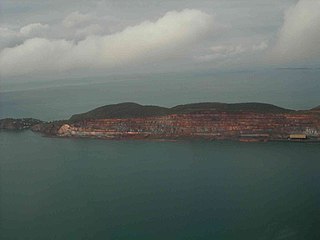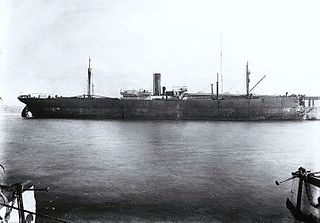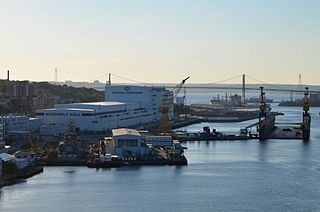
Whyalla was founded as "Hummocks Hill", and was known by that name until 1916. It is the fourth most populous city in the Australian state of South Australia after Adelaide, Mount Gambier and Gawler. As at June 2018, Whyalla had an urban population of 21,742, having declined at an average annual rate of -0.75% year-on-year over the preceding five years. It is a seaport located on the east coast of the Eyre Peninsula and is known as the "Steel City" due to its integrated steelworks and shipbuilding heritage. The port of Whyalla has been exporting iron ore since 1903.

Union Iron Works, located in San Francisco, California, on the southeast waterfront, was a central business within the large industrial zone of Potrero Point, for four decades at the end of the nineteenth and beginning of the twentieth centuries.

Iron Knob is a town in the Australian state of South Australia on the Eyre Peninsula immediately south of the Eyre Highway. At the 2006 census, Iron Knob and the surrounding area had a population of 199. The town obtained its name from its proximity to large deposits of iron ore, most notably Iron Monarch which outcropped prominently from the relatively flat, surrounding landscape.

Cockatoo Island is an island in the Buccaneer Archipelago off the coast of Western Australia near the town of Derby. It was mined for iron ore by the Broken Hill Proprietary Company from 1951 until 1984. Koolan Island is a neighbouring island that was also mined by BHP for high grade iron ore. It was most recently mined by Perth-based mining company, Pluton Resources until the company was placed under administration in September 2015.

Storstad was a steam cargo ship built in 1910 by Armstrong, Whitworth & Co Ltd of Newcastle for A. F. Klaveness & Co of Sandefjord. The ship was primarily employed as an ore and coal carrier doing tramp trade during her career. She is best known for accidentally ramming and sinking the ocean liner RMS Empress of Ireland in 1914, killing over 1,000 people.

Polska Żegluga Morska known as Polsteam or PŻM, is a cargo ship operator based in Szczecin, Poland. Polsteam is a state-owned enterprise with around 3,000 employees.

The Great Lakes Engineering Works (GLEW) was a leading shipbuilding company with a shipyard in Ecorse, Michigan, that operated between 1902 and 1960. Within three years of its formation, it was building fifty percent of the tonnage of all ships in the Great Lakes. During World War II, GLEW was commissioned by Pittsburgh Steamship Company and the U.S. Maritime Commission to build twenty-one ore freighters. Its innovations included the first self-unloader freighter, SS Wyandotte. GLEW is best known for its construction of the SS Edmund Fitzgerald.

The Halifax Shipyard Limited is a Canadian shipbuilding company located in Halifax, Nova Scotia.

The Whyalla Steelworks is a fully integrated steelworks and the only manufacturer of rail in Australia. Iron ore is mined in the Middleback Range to feed the steelworks, resulting in the distribution of finished steel products of over 90 different grades. It occupies a 1,000 ha site on the shore of False Bay, Spencer Gulf and is the largest employer in Whyalla, South Australia.

HMAS Koolonga was a 4,260 gross tons cargo ship built by Sunderland Shipbuilding Company, South Dock Sunderland, England, in 1914 and bought by McIlwraith, McEacharn Line Pty Ltd, Melbourne and named SS Koolonga. She was requisitioned by the Royal Australian Navy on 6 August 1914, as a collier and supply ship. She was returned to her owners in late 1915. She was sold in 1937 to Madrigal & Company, Philippines and renamed Paz. She was scuttled during the Second World War at Sourabaya Harbour in 1942 and was later salvaged by the Imperial Japanese and renamed Hatsu Maru. While at anchor in Manila Bay, Philippines on 13 November 1944, she was attacked by United States Navy carrier aircraft and was sunk.

Valemax ships are a fleet of very large ore carriers (VLOC) owned or chartered by the Brazilian mining company Vale S.A. to carry iron ore from Brazil to European and Asian ports. With a capacity ranging from 380,000 to 400,000 tons deadweight, the vessels meet the Chinamax standard of ship measurements for limits on draft and beam. Valemax ships are the largest bulk carriers ever constructed, when measuring deadweight tonnage or length overall, and are amongst the longest ships of any type currently in service.

SS War Toronto was a small freighter built in Toronto, in 1918, by Toronto Dry Dock & Ship Building Company Limited. She was one of 72 cargo vessels built under the authority of Canada's Imperial Munitions Board for wartime service in the First World War, and one of the 46 vessels with hulls built of wood. She displaced 2,500 deadweight tonnes. Toronto Shipbuilding also constructed a sister wood-hull ship at the same time, the SS War Ontario.

SS Onoko was an iron hulled Great Lakes freighter. She was launched in 1882 in Cleveland, Ohio as hull number #4, and sank on September 14, 1915 in Lake Superior near Knife River, Minnesota. Onoko is thought to be the prototype for every single steel hulled Great Lakes Bulk carrier that ever sailed. These vessels made possible the cheap transport of bulk cargoes such as iron ore, coal and limestone. Her wreckage still remains on the bottom of Lake Superior and was listed on the National Register of Historic Places in 1992.
Tellus was a steam cargo ship built in 1911 by the William Doxford & Sons of Pallion for the Wabanas Dampskibskompani, a subsidiary of Nova Scotia Steel & Coal Company and managed by Wilhelm Wilhelmsen. She was named after Tellus, the Earth goddess.

Themis was a steam cargo ship built in 1911 by the William Doxford & Sons of Pallion for the Wabanas Dampskibskompani, a subsidiary of Nova Scotia Steel & Coal Company and managed by Wilhelm Wilhelmsen. She was named after Themis, Titaness of divine law and order.
Wacousta was a steam cargo ship built in 1908 by the Archibald McMillan & Son of Dumbarton for the Wacousta Dampskibskompani, originally managed by Peter Anton Grøn of Sandefjord, and subsequently transferred to Christensen & Stenseth in March 1915. She was named after a fictional character from a novel Wacousta by John Richardson, published in 1832. The ship was primarily employed as a collier during her career.
Sangstad was a steam cargo ship built in 1904 by the Robert Thompson & Sons of Sunderland for A. F. Klaveness & Co of Sandefjord. She was primarily employed as an ore carrier and collier doing tramp trade during her career.
Wegadesk was a steam cargo ship built in 1908 by the Burmeister & Wain of Copenhagen for A. F. Klaveness & Co of Sandefjord. Her name means Northern Lights in Mi'kmaq language. The ship was primarily employed as an ore and coal carrier during her career.
William O'Brien was a steam cargo ship built in 1914–1915 by New York Shipbuilding Company of Camden for the Carpenter–O'Brien Lumber Company of Delaware. The vessel was extensively employed on East Coast to Europe routes during her career and foundered on one of her regular trips in April 1920.

Craig Shipbuilding was a shipbuilding company in Long Beach, California. To support the World War 1 demand for ships Craig Shipbuilding shipyard switched over to military construction and built: US Navy Submarines and Cargo Ships. Craig Shipbuilding was started in 1906 by John F. Craig. John F. Craig had worked in Toledo, Ohio with his father, John Craig (1838-1934), and Blythe Craig, both shipbuilders, their first ship was built in 1864 at Craig Shipbuilding Toledo. John F. Craig opened his shipbuilding company in Port of Long Beach on the south side of Channel 3, the current location of Pier 41 in the inner harbor, becoming the port's first shipyard. In 1907 Craig Shipbuilding is given a contract to dredge a channel from the Pacific ocean to the inner harbor. In 1917 Craig sold the shipyard to the California Shipbuilding Company. But then opened a new shipyard next to the one he just sold and called it the Long Beach Shipbuilding Company. The Long Beach Shipbuilding Company built cargo ships in 1918, 1919, and 1920 for the United States Shipping Board.















